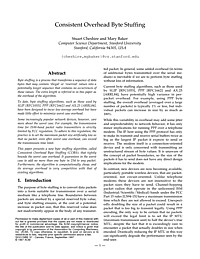A Survey of Techniques For Improving Energy Efficiency in Embedded Computing Systems
Recent technological advances have greatly improved the performance and features of embedded systems. With the number of just mobile devices now reaching nearly equal to the population of earth, embedded systems have truly become ubiquitous. These trends, however, have also made the task of managing their power consumption extremely challenging. In recent years, several techniques have been proposed to address this issue. In this paper, we survey the techniques for managing power consumption of embedded systems. We discuss the need of power management and provide a classification of the techniques on several important parameters to highlight their similarities and differences. This paper is intended to help the researchers and application-developers in gaining insights into the working of power management techniques and designing even more efficient high-performance embedded systems of tomorrow.
Embedded Systems – Theory and Design Methodology
This book addresses a wide spectrum of research topics on embedded systems, including basic researches, theoretical studies, and practical work.

Consistent Overhead Byte Stuffing
Byte stuffing is a process that transforms a sequence of data bytes that may contain ‘illegal’ or ‘reserved’ values into a potentially longer sequence that contains no occurrences of those values. The extra length is referred to in this paper as the overhead of the algorithm. To date, byte stuffing algorithms, such as those used by SLIP [RFC1055], PPP [RFC1662] and AX.25 [ARRL84], have been designed to incur low average overhead but have made little effort to minimize worst case overhead. Some increasingly popular network devices, however, care more about the worst case. For example, the transmission time for ISM-band packet radio transmitters is strictly limited by FCC regulation. To adhere to this regulation, the practice is to set the maximum packet size artificially low so that no packet, even after worst case overhead, can exceed the transmission time limit. This paper presents a new byte stuffing algorithm, called Consistent Overhead Byte Stuffing (COBS), that tightly bounds the worst case overhead. It guarantees in the worst case to add no more than one byte in 254 to any packet. Furthermore, the algorithm is computationally cheap, and its average overhead is very competitive with that of existing algorithms.
Embedded Systems – Theory and Design Methodology
This book addresses a wide spectrum of research topics on embedded systems, including basic researches, theoretical studies, and practical work.

Consistent Overhead Byte Stuffing
Byte stuffing is a process that transforms a sequence of data bytes that may contain ‘illegal’ or ‘reserved’ values into a potentially longer sequence that contains no occurrences of those values. The extra length is referred to in this paper as the overhead of the algorithm. To date, byte stuffing algorithms, such as those used by SLIP [RFC1055], PPP [RFC1662] and AX.25 [ARRL84], have been designed to incur low average overhead but have made little effort to minimize worst case overhead. Some increasingly popular network devices, however, care more about the worst case. For example, the transmission time for ISM-band packet radio transmitters is strictly limited by FCC regulation. To adhere to this regulation, the practice is to set the maximum packet size artificially low so that no packet, even after worst case overhead, can exceed the transmission time limit. This paper presents a new byte stuffing algorithm, called Consistent Overhead Byte Stuffing (COBS), that tightly bounds the worst case overhead. It guarantees in the worst case to add no more than one byte in 254 to any packet. Furthermore, the algorithm is computationally cheap, and its average overhead is very competitive with that of existing algorithms.
A Survey of Techniques For Improving Energy Efficiency in Embedded Computing Systems
Recent technological advances have greatly improved the performance and features of embedded systems. With the number of just mobile devices now reaching nearly equal to the population of earth, embedded systems have truly become ubiquitous. These trends, however, have also made the task of managing their power consumption extremely challenging. In recent years, several techniques have been proposed to address this issue. In this paper, we survey the techniques for managing power consumption of embedded systems. We discuss the need of power management and provide a classification of the techniques on several important parameters to highlight their similarities and differences. This paper is intended to help the researchers and application-developers in gaining insights into the working of power management techniques and designing even more efficient high-performance embedded systems of tomorrow.



















